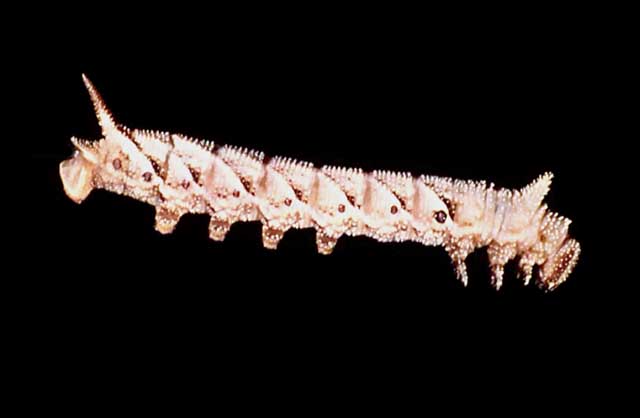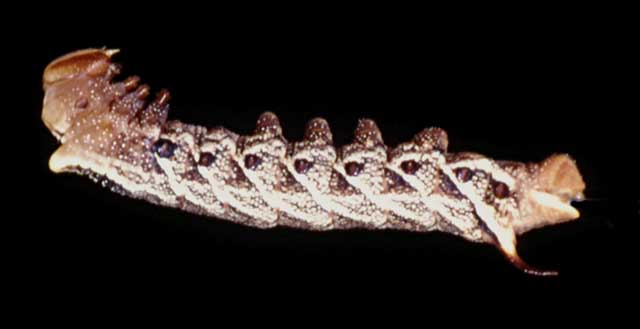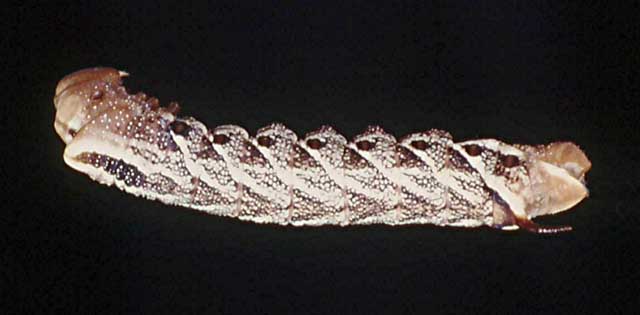
Lintneria pseudostigmatica fourth instar, courtesy of James A. Tuttle.

Lintneria pseudostigmatica fifth instar, courtesy of James A. Tuttle.

Lintneria pseudostigmatica fifth instar, courtesy of James A. Tuttle.
|
|
Updated as per The Hawk Moths of the North America, 2007, James P. Tuttle (Sphinx to Lintneria); April 2009 Updated as per CATE; April 2009 Updated as per personal communication with James P. Tuttle (alcohol preserved larval images); May 2009 |
This site has been created by
Bill Oehlke at oehlkew@islandtelecom.com
Comments, suggestions and/or additional information are welcomed by Bill.
TAXONOMY:
Family: Sphingidae, Latreille, 1802 |
MIDI MUSICcopyright C. Odenkirk ON.OFF |
The species was found on Salvia ballotaeflora (Lamiaceae) near Rio Verde, San Luis Potosi (SLP), Mexico by Roy Kendall (James P. Tuttle).
In his The Hawk Moths of North America, 2007, James P. Tuttle has assigned all the Sphinx genus species (except Sphinx adumbrata) from Mexico south throughout South American to Lintneria, Butler, 1876, based on consistent differences in wing characters and significant larval differences.
"Similar in size and pattern to Lintneria eremitus, but the wings are slimmer; ground colour of head, thorax and forewing uppersides more grey-brown,
without a yellowish tint, generally darker.
"Palp with 2nd and 3rd segments very robust, with longer hairs than Lintneria eremitus. Abdomen upperside with the grey dorsal band much narrower than in
Lintneria eremitus, the mesial black line very thin.
"Abdomen underside darker grey than in Lintneria eremitus.
"Forewing upperside with pattern similar to that of Lintneria eremitus, but less well-marked, almost all the lines being thin, in particular the 2 longitudinal dark
discal stripes; no white zigzag submarginal line near the hind angle; discal spot not so well-marked, but a bright spot present in the discal cell; fringe brown, less
bright between the veins than in Lintneria eremitus.
"Underside of both wings more grey and less well-marked than in Lintneria eremitus." CATE
Jim Tuttle has provided images of the following fourth and fifth instar larvae. He indicates colours may be off as these have been preserved in alcohol.

Lintneria pseudostigmatica fourth instar, courtesy of James A. Tuttle.

Lintneria pseudostigmatica fifth instar, courtesy of James A. Tuttle.

Lintneria pseudostigmatica fifth instar, courtesy of James A. Tuttle.
Although they may be encountered feeding during daylight hours, one is even more likely to discover them feeding in the evening or after dark.
Two of the greatest clues for discovering larvae are stripped foliage and droppings beneath the plant. You might be quite surprised at what will turn up in the evening or after dark in a flashlight assisted search.
It is believed that all "Lintneria larvae will exhibit "a fleshy thoracic dorsal "horn" in the first 4 instars (unique in the Sphingidae of the world to my knowledge) which is replaced by a thoracic dorsal "hump" with a large black patch in the 5th instar." J.A. Tuttle.
Return to U.S.A. Table
Return to Sphingidae Index
Return to Sphingini Tribe
Use your browser "Back" button to return to the previous page.
This page is brought to you by Bill Oehlke and the WLSS. Pages are on space rented from Bizland. If you would like to become a "Patron of the Sphingidae Site", contact Bill.
Please send sightings/images to Bill. I will do my best to respond to requests for identification help.
Enjoy one of nature's wonderments: Live Saturniidae (Giant Silkmoth) cocoons.
 Show appreciation for this site by clicking on flashing butterfly to the left. The link will take you to a page with links to many insect sites. |